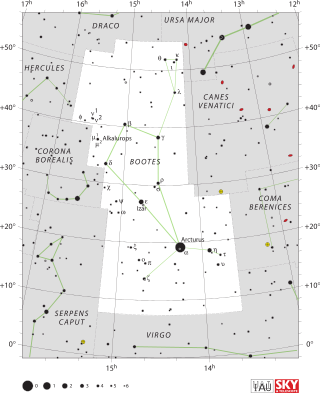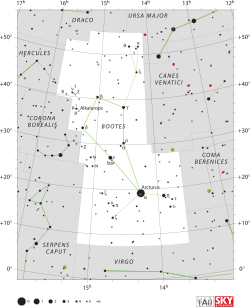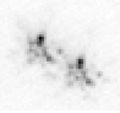Top Qs
Timeline
Chat
Perspective
Zeta Boötis
Star system in the constellation Boötes From Wikipedia, the free encyclopedia
Remove ads
Zeta Boötis is a binary star system in the constellation of Boötes that forms a triple star system with HIP 71759. Its name is a Bayer designation that is Latinized from ζ Boötis, and abbreviated Zeta Boo or ζ Boo. They have the Flamsteed designation 30 Boötis. This system is visible to the naked eye as a point of light with an apparent visual magnitude of +3.78.[2] The individual magnitudes of the components differ slightly, with component A having a magnitude of 4.46 and component B at the slightly dimmer magnitude 4.55.[3] The system is located at a distance of approximately 180 light years based on parallax,[1] but is drifting closer to the Sun with a radial velocity of −9 km/s.[9]
Remove ads
Observations
The duplicity of this star was discovered by English astronomer William Herschel in 1796, and their changing positions have been tracked from 1823 onward.[15]
In 1976, T. W. Edwards found a stellar classification of A2III for both inner components, suggesting they may be evolved A-type giant stars. Helmut A. Abt reported a class of A2V in 1981, which matches an A-type main-sequence star.[16] Abt and Nidia Morrell updated the classification to A1V in 1995.[6]
Remove ads
Characteristics
Summarize
Perspective
The two components of the pair, Zeta Boötis A and B, are A-type main-sequence stars. Component A has 2.21 times the Sun's mass, 2.6 times the Sun's radius and an effective temperature of 8,800 K. Component B has 2.15 times the Sun's mass, 2.4 times the Sun's radius and an effective temperature of 8,750 K. Their estimated age is 560 million years.[11]
The stars take 125 years to orbit each other. The orbit of this pair has a very high eccentricity of 0.98045, bringing them within 0.818 au at their closest approach (periastron). As of 2025[update], the eccentricity of this system is possibly the second-highest known, after HIP 26245, whose eccentricity is 0.985±0.002. The last periastron occurred during November 2023.[11] Considering the extreme nature of their orbit, it is unlikely that any exoplanets could have stable orbits around either star.[17]
Together with the star HIP 71759, Zeta Boötis make a triple star system. This distant star has an estimated orbital period of three million years, being at an observed distance of 41,300 au (6,180×109 km; 0.653 ly) from the inner pair. The orbit of this star is likely what forced the high eccentricity orbit of the inner pair, via the Kozai mechanism.[18] It has a class of F0V, matching an F-type main-sequence star.[7] It is a Delta Scuti variable with a brightness amplitude of 0.00134 magnitudes.[8]
Remove ads
Gallery
- Zeta Bootis imaged with the Nordic Optical Telescope on 13 May 2000 using the lucky imaging method. (The Airy discs around the stars is diffraction from the 2.56m telescope aperture.)
- Typical short-exposure image of a binary star, as seen using speckle imaging through the Earth's atmosphere.
References
External links
Wikiwand - on
Seamless Wikipedia browsing. On steroids.
Remove ads



